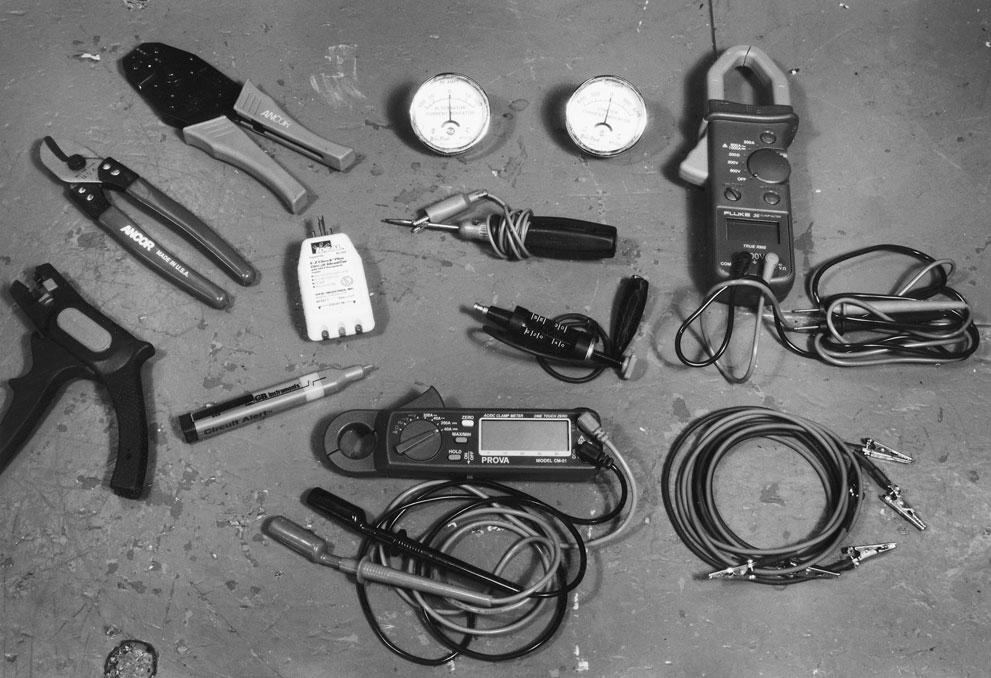
2 minute read
Tools
(the feed) has somehow connected itself directly to ground before reaching the appliance. In a short to ground, the resistance in the circuit (which you’ll remember is essential for a circuit to operate) has been circumvented. As Ohm’s law will tell you if you work through the numbers, a lot of amperage will flow with only the resistance of the wire to stop it. The good news: If the circuit is designed correctly, the fuse or circuit breaker will trip. The bad news: Some wire and insulation may be burned before the circuit protection opens the circuit.
Intercircuit Shorts
The second variety of short is what I refer to as the intercircuit short. With this type, two or more electrical circuits will be affected simultaneously. The cause? Drilling through a wiring harness to install new deck gear and then running a screw down through the deck into the harness, effectively connecting multiple circuit wires. This short circuit with a screw is quite common. Another frequent cause for this type of short is not thinking dynamically. Remember, our electrical system will change when the engine is running and while we are underway. Wiring harnesses that rub against moving pulleys, hot exhaust manifolds, and the like are electrical time bombs. Check to be sure all wiring is properly secured and clearance from moving machinery is adequate.
Internal Shorts
The third and final short circuit type we will discuss is the internal short, a short circuit that can occur deep within the internal circuitry of the electrical appliance itself. This type of short circuit is the most harmless of the three because it doesn’t usually threaten the safety of our boats. Internal shorts can, however, be expensive to correct because they often mean that expensive equipment will have to go into the repair shop or worse, into the dumpster. Often a short inside a piece of equipment will simply cause the equipment to stop functioning. At other times the fuse or circuit breaker will trip without the risk of burned wires or insulation (assuming the circuit protection is rated properly).
Most of us will already have a good collection of basic tools. However, besides our regular collection of sockets, spanner wrenches, screwdrivers, pliers, and the like we’ll need to acquire a few more specific items. Once we start working with electricity and begin performing serious electrical troubleshooting procedures and upgrades, we are going to need specialized equipment that will allow us to work safely and do a proper job.
Figure 1-9,a photo of my personal collection of tools, shows some of this equipment.
Technology has been good to us electricians in the last several years, and significant improvements in tools and equipment have been made, specifically in the areas of multimeters and crimping tools (we take a closer look at these in chapters 3 and 4). As you go through this book, you’ll see these tools in use, with specific instructions for every test procedure you’ll ever need on board your boat.
B C
D E
K
I J
A
H
G F
Fig. 1-9. Some basic and not-so-basic electrical tools from my collection. Beginning at the lower left and moving clockwise are (A) wire stripper, (B) cable cutter, (C) ratcheting crimping tool, (D) inexpensive Snap-On inductive ammeters, (E) Fluke 36 high-amperage inductive multimeter (true RMS), (F) miscellaneous jumper leads used for various tests, (G) the Ancor/Prova inductive ammeter with frequency scale, (H) AC probe pen, (I) AC LED socket (outlet) tester, (J) Snap-On ignition spark tester, (K) 12 V test light/probe.




